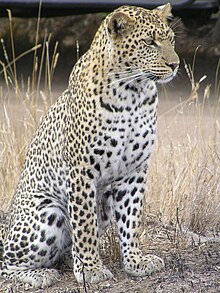| Revision as of 08:11, 5 July 2017 editLeo1pard (talk | contribs)Extended confirmed users28,569 edits More specifically.← Previous edit | Revision as of 11:38, 5 July 2017 edit undoBhagyaMani (talk | contribs)Extended confirmed users, Pending changes reviewers56,101 editsm →top: changed img of fence in boxNext edit → | ||
| Line 3: | Line 3: | ||
| <!-- | status = CR | <!-- | status = CR | ||
| | status_system = iucn3.1 --> | | status_system = iucn3.1 --> | ||
| | image = |
| image = Leopard africa.jpg | ||
| | regnum = ]ia | | regnum = ]ia | ||
| | phylum = ] | | phylum = ] | ||
Revision as of 11:38, 5 July 2017
| Barbary leopard | |
|---|---|

| |
| Scientific classification | |
| Kingdom: | Animalia |
| Phylum: | Chordata |
| Class: | Mammalia |
| Order: | Carnivora |
| Family: | Felidae |
| Genus: | Panthera |
| Species: | P. pardus |
| Subspecies: | P. p. panthera |
| Trinomial name | |
| Panthera pardus panthera (Schreber, 1777) | |
The Barbary leopard or North African leopard from the Atlas Mountains of North Africa has initially been described as a leopard subspecies (Panthera pardus panthera) in the late 18th century. Following genetic analysis in the 1990s, this population is grouped with the African leopard (P. p. pardus).
Distribution and habitat

Leopards are rare in northern Africa. Only small populations persist in the Atlas Mountains of Morocco and Algeria, in forest and mountain steppe in elevations of 300 to 2,500 m (980 to 8,200 ft), where the climate is temperate to cold.
Ecology
The Barbary macaque also lives in this area and habitat. The leopard acts as a predator of the macaque, and nowadays, there are no wild lions and bears in the Atlas region to compete with leopards over prey.
See also
References
- Miththapala, S.; Seidensticker, J.; O'Brien, S. J. (1996). "Phylogeographic Subspecies Recognition in Leopards (P. pardus): Molecular Genetic Variation". Conservation Biology. 10 (4): 1115–1132. doi:10.1046/j.1523-1739.1996.10041115.x.
- Uphyrkina, O.; Johnson, E.W.; Quigley, H.; Miquelle, D.; Marker, L.; Bush, M.; O'Brien, S. J. (2001). "Phylogenetics, genome diversity and origin of modern leopard, Panthera pardus" (PDF). Molecular Ecology. 10 (11): 2617–2633. doi:10.1046/j.0962-1083.2001.01350.x. PMID 11883877.
- Cuzin, F. (2003). Les grands mammifères du Maroc méridional (Haut Atlas, Anti Atlas et Sahara): Distribution, Ecologie et Conservation. Ph.D. Thesis, Laboratoire de Biogéographie et Ecologie des Vertèbrés, Ecole Pratique des Hautes Etudes, Université Montpellier II.
- Busby, G. B. J., Gottelli, D., Durant, S., Wacher, T., Marker, L., Belbachir, F., de Smet, K., Belbachir-Bazi, A., Fellous, A. and Belghoul, M. (2006). A Report from the Sahelo Saharan Interest Group - Parc National de l'Ahaggar Survey, Algeria (March 2005). Part 5: Using Molecular Genetics to study the Presence of Endangered Carnivores.
- Van Lavieren, E. (2012). The Barbary Macaque (Macaca sylvanus); A unique endangered primate species struggling to survive. Revista Eubacteria, (30): 1–4.
- Emmanuel, John (September 1982). "A Survey Of Population and Habitat of the Barbary Macaqu Macaca Sylvanus L. In North Morocco". Biologoical Conservation. 24 (1): 45–66. doi:10.1016/0006-3207(82)90046-5.
- Bryden, H. A. (ed.) (1899). Great and small game of Africa Rowland Ward Ltd., London. Pp. 544–608.
- Schaller, p. 220–21.
- Nowell, Kristin; Jackson, Peter (1996). Wild Cats: Status Survey and Conservation Action Plan (PDF). Gland, Switzerland: IUCN/SSC Cat Specialist Group. pp. 1–334. ISBN 2-8317-0045-0.
External links
- Video of the Barbary Leopard in the wild (broken link)
- Examining the Extinction of the Barbary Lion and Its Implications for Felid Conservation
This felid-related article is a stub. You can help Misplaced Pages by expanding it. |